
Diuris pardina, commonly known as the leopard orchid or leopard doubletail is a species of orchid which is endemic to south-eastern Australia. It has two or three grass-like leaves and up to ten yellow flowers with reddish-brown marks and blotches.

Caladenia angustata, commonly known as white caps is a species of orchid endemic to Tasmania. It has a single, hairy leaf and one or two white to pinkish flowers which are reddish or greenish on their backs. It has not been accepted as a separate species by some authorities who regard it as a synonym of Caladenia gracilis.

Dendrobium antennatum, commonly known as the green antelope orchid, is an epiphytic orchid in the family Orchidaceae. It has cylindrical pseudobulbs with up to twelve leaves near their tips and up to fifteen white flowers with green petals and a white labellum with purple stripes. It grows in New Guinea and in tropical North Queensland where it is rare.

Dendrobium bigibbum, commonly known as the Cooktown orchid or mauve butterfly orchid, is an epiphytic or lithophytic orchid in the family Orchidaceae. It has cylindrical pseudobulbs, each with between three and five green or purplish leaves and arching flowering stems with up to twenty, usually lilac-purple flowers. It occurs in tropical North Queensland, Australia and New Guinea.
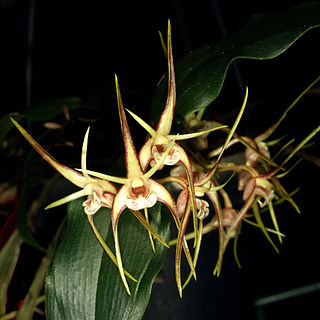
Dendrobium tetragonum, commonly known as the tree spider orchid, is a variable species of epiphytic or lithophytic orchid endemic to eastern Australia. Tree spider orchids are unusual in having pendulous pseudobulbs that are thin and wiry near the base then expand into a fleshy, four-sided upper section before tapering at the tip. There are only a few thin but leathery leaves at the end of the pseudobulbs and up to five flowers on relatively short flowering stems. To allow for the variations in the species there are five subspecies and a variety, some with a unique common name.

Eulophia pulchra, commonly known as the gonzo orchid, is a plant in the orchid family and is native to areas from Tanzania and Mozambique to the Western Pacific Ocean. It is a terrestrial orchid with crowded, above-ground pseudobulbs, two or three leaves and pale yellowish green flowers with dull purple or red markings. It grows in plant litter in rainforests.

Burnettia cuneata, commonly known as the lizard orchid, is the only species of the flowering plant genus Burnettia in the orchid family, Orchidaceae. It is a leafless terrestrial, mycotrophic herb with one or two leaf-like bracts and up to seven flowers that are brownish on the back and pink or white inside. It is endemic to southeastern Australia where it grows in dense thickets in swamps.

Dendrobium pugioniforme, commonly known as the dagger orchid is a species of orchid endemic to eastern Australia. It is an epiphytic or lithophytic orchid with pendulous, wiry stems, fleshy, sharply pointed leaves and flowering stems with one or two greenish or yellowish flowers with a white labellum. It grows on trees and rocks, mostly in humid forest.
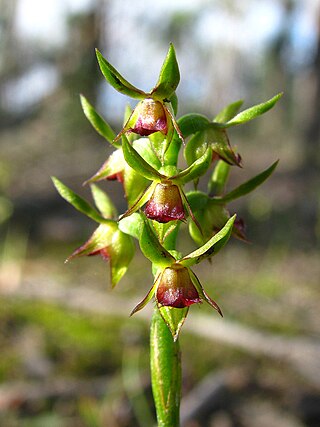
Corunastylis ciliata, commonly known as the fringed midge orchid, is a small terrestrial orchid endemic to southern Australia. It has a single thin leaf fused to the flowering stem and up to fifteen small, green to greenish yellow flowers with purplish markings and a reddish purple labellum. It was formerly included with Corunastylis archeri, and C. ciliata is regarded as a synonym of Genoplesium archeri by the World Checklist of Selected Plant Families. Plants in this species have fewer, more erect flowers, a less-hairy labellum and have different coloration than C. archeri.
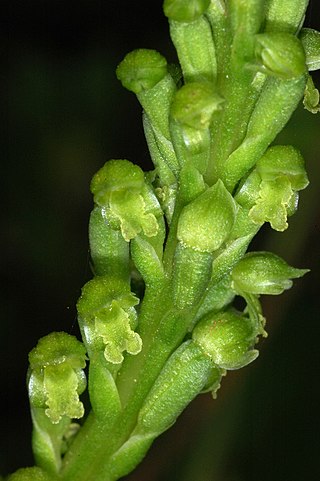
Microtis arenaria, commonly known as the notched onion orchid, is a species of orchid endemic to south-eastern Australia. It has a single hollow, onion-like leaf and up to sixty scented, crowded yellowish-green flowers. It is widespread and common, growing in a wide variety of habitats.
Diuris fucosa is a species of orchid that is endemic to New South Wales. It between four and seven leaves and up to four pale yellow flowers with a few brown striations. It is only known from two sites in Callitris woodland in the south of the state and is classed as "extinct" in Victoria.
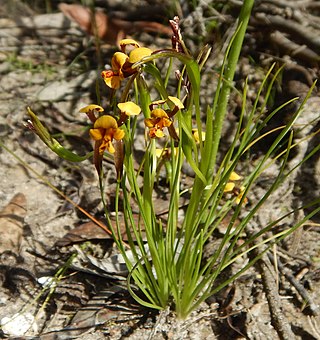
Diuris palustris, commonly known as the swamp doubletail or swamp diuris is a species of orchid which is endemic to south-eastern Australia. It has a tuft of between eight and ten twisted leaves and up to four yellow flowers with brown spots and blotches marks and blotches.
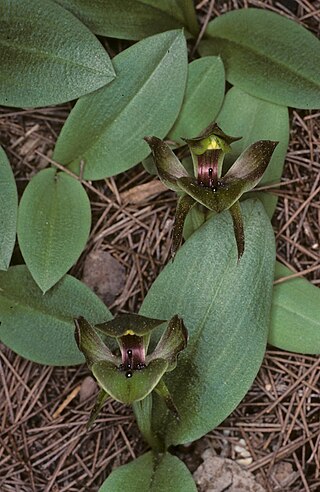
Chiloglottis gunnii, commonly known as the tall bird orchid, is a species of orchid endemic to Tasmania. It has two broad leaves and a single green to purplish brown flower with a line of erect calli with swollen heads along the mid-line of the labellum. It is widespread but mainly in coastal districts and most commonly in moist to wet forest.
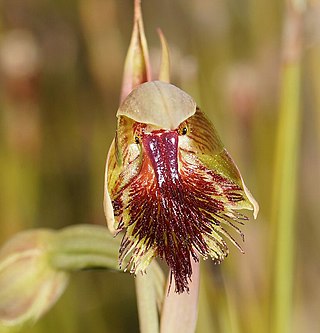
Calochilus herbaceus, commonly known as the copper beard orchid or pale beard orchid, is a species of orchid native to south-eastern Australia and northern New Zealand. It has a single very short, rigid, fleshy leaf and up to eight pale green to brownish flowers with reddish stripes and a purple "beard".

Dendrobium lobbii, commonly known as the straggly rush orchid, is a plant in the orchid family Orchidaceae and is native to an area extending from Indochina to northern Australia. It has thin, wiry stems with stiff leaves and mostly white or cream-coloured flowers singly or in pairs in leaf axils. Its white labellum does not open widely and sometimes remains closed.

Corymborkis veratrifolia, commonly known as the white cinnamon orchid is a plant in the orchid family and is native to areas from tropical and subtropical Asia to Australia and the Pacific Islands. It is an evergreen, terrestrial orchid with a thin, upright stem, papery, pleated leaves and a short flowering stems with up to sixty crowded, short-lived green and white flowers.

Dendrobium bifalce, commonly known as the native bee orchid, is an epiphytic or lithophytic orchid in the family Orchidaceae. It has spindle-shaped pseudobulbs with up to four leathery leaves and up to ten pale green or greenish yellow flowers with purplish markings. It grows on trees and boulders in rainforest in tropical North Queensland, Australia and in New Guinea.

Dendrobium macrostachyum, commonly known as the fringed tree orchid, is a species of epiphytic orchid with long, narrow pseudobulbs that lose their leaves as they mature, and up to three whitish to lime green flowers with a hairy labellum. It is native to Australia, tropical Asia and eastern Malesia.

Micropera fasciculata, commonly known as the pale dismal orchid, is a species of epiphytic or lithophytic orchid with wiry stems forming large, tangled clumps. It has stiff, leathery leaves and flowering stems with between ten and twenty cream-coloured flowers with a white labellum. This orchid occurs in New Guinea, Queensland, the Solomon Islands and New Caledonia.

Oberonia crateriformis, commonly known as the cratered fairy orchid, is a plant in the orchid family and is a clump-forming epiphyte or lithophyte. It has between four and six leaves in a fan-like arrangement on each shoot and a large number of pale red flowers arranged in whorls of eight around the flowering stem. It is endemic to Queensland.




















